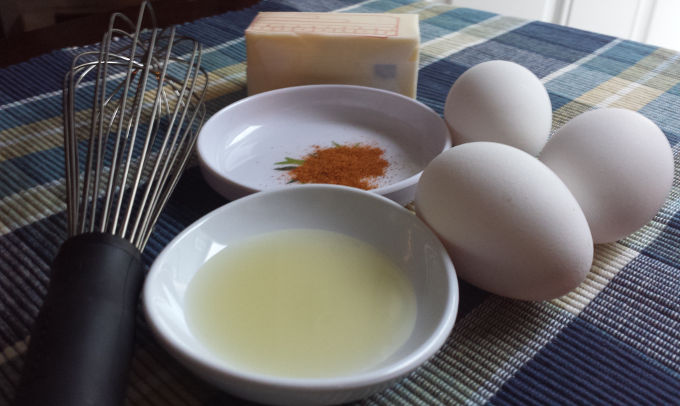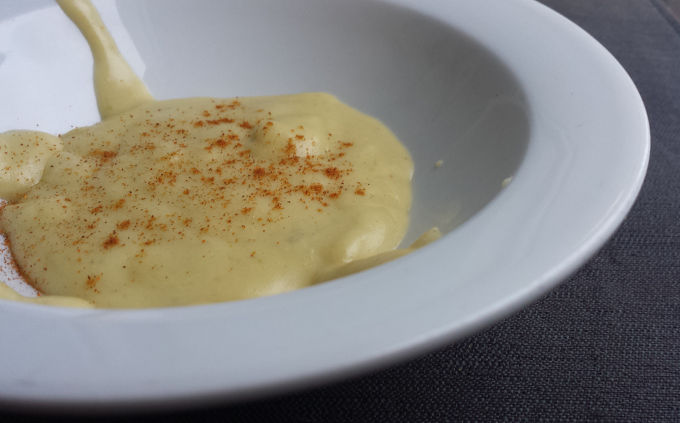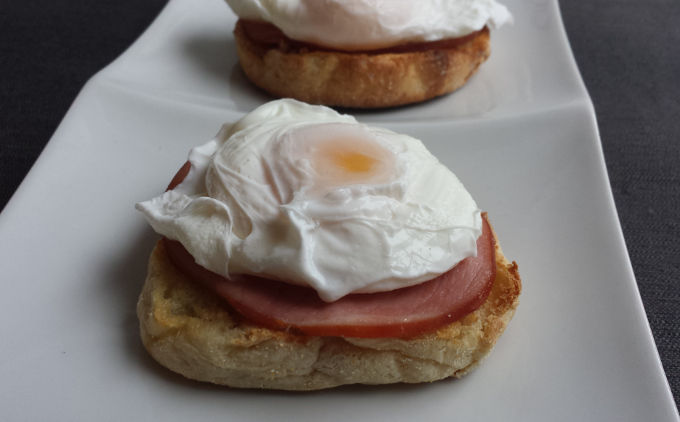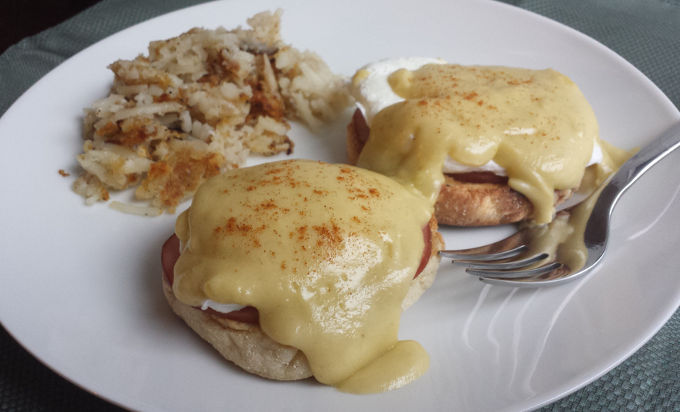
It’s hard to find a dish that can top the sheer anticipation of tearing into the first bite of a couple of eggs Benedict. Featuring crispy buttery English muffins topped with poached eggs and Canadian bacon. The yolk slowly drizzles it’s way down the English muffin before mixing with the Hollandaise sauce to become the perfect meld of brunchenly flavors. I just made the word “brunchenly” up right then, but I think it has some possibility. Many people consider eggs Benedict to be something that only fancy restaurants serve during their brunches, and well that might be true to some extent, I think it’s nothing but a stereotype. It’s far easier to make eggs Benedict than most people, maybe even you included realize. In fact, the only part of it that might be considered tricky is making the Hollandaise sauce. Even that though, is super easy if you just take it slow and don’t apply too much heat.
If you take a quick look online, you will find a dozen different ways to make this supposedly finicky sauce. Some of them require blenders, while others require two people, while others call for using multiple sauce pans. Simpler is better in my opinion, but I will say that using a blender might be a good idea for some, because the recipe I will show you later on does require a good bit of whisking, but like I said earlier it’s really hard to mess it up If you dissolve the butter slowly.
Now to be honest, before continuing I have to say something about Hollandaise because I don’t want to sound ignorant. First, it actually is considered one of the harder sauces to make because there is a slim range of temperatures it needs to fall between while cooking or it will separate and fall apart making it pretty useless, unless you like melted butter with some egg-yolk in it. But with that being said, there should be no reason to avoid making Hollandaise because it sounds too complicated. If it does fall apart on you, try adding another egg yoke, turning the heat down a tad, and continue whisking. Or if all else fails, toss it and start over again. Most of the problem comes from adding the butter too quickly. So when a recipe tells you to slowly pour in the melted butter while whisking thoroughly, it should probably say, add the butter in a couple drops at a time until you can clearly see that the sauce has taken, before adding it in larger quantities. Or if you choose to make it like I do, let the butter slowly melt while whisking the mixture and you really can’t mess it up. Have I mention at the end of each paragraph to slowly let the butter melt? This is reassurance that you won’t overheat the mixture, and have it fall apart on you.
Hollandaise Sauce
By: Semiserious Chefs
Serves: Varies
Ingredients:
- 6 large egg yolks
- 2 tablespoons lemon juice (I like to add a couple extra drops)
- 1 cup chilled unsalted butter (two – 4 oz sticks)
- Salt (to taste)
- Pinch of cayenne pepper (or to taste)
Directions:
- In a small sauce pan, whisk the egg yolks and the lemon juice until thoroughly blended.
- Turn on heat to low and begin by adding a quarter cup of chilled butter, or half a stick of chilled butter into the sauce pan, making sure the butter is slowly melting. Continue whisking the mixture. Fair warning, it’s basically going to be nonstop whisking until the sauce has thickened, so be prepared.
- Continue adding an additional quarter cup of butter when the previous butter has melted and continue whisking. You can add a dash of salt and cayenne pepper if you like, or you can wait til the sauce is thickened.
- If all went well, all the butter should be melted into the Hollandaise and it should visibly begin to thicken up as it is whisked over low heat. If it hasn’t noticeably thickened by this point, turn the heat up just a little and continue to whisk. Once it thickens, remove the Hollandaise from the heat or it runs the chance of separating on you.
- Sometimes things just don’t seem to come together, so if you are having a problem with the sauce separating, chances are you are cooking it over too high of heat. If you notice it wanting to come apart, you can try adding a tablespoon of hot water, or another egg yolk and quickly whisk it until it hopefully comes back together.
Alright, I’m done with the butter melting thing and I’ll move on I promise. But while we’re still talking about making the sauce, I want to share with you what Wikipedia has to say about Hollandaise sauce.
Being a mother sauce, hollandaise sauce is the foundation for many derivatives created by adding or changing ingredients. The following is a non-exhaustive listing of such minor sauces.
- The most common derivative is Sauce Béarnaise. It can be produced by replacing the acidifying agent (vinegar reduction or lemon juice) in a preparation with a strained reduction of vinegar, shallots, fresh chervil, fresh tarragon and (if to taste) crushed peppercorns.[21][22][23] Alternatively, the flavorings may be added to a standard hollandaise. Béarnaise and its children are often used on steak or other “assertive” grilled meats and fish.
- Sauce Choron is a variation of béarnaise without tarragon or chervil, plus added tomato purée.[23][24]
- Sauce Foyot (a.k.a. Valois) is béarnaise with meat glaze (Glace de Viande) added.[23][25]
- Sauce Colbert is Sauce Foyot with the addition of reduced white wine.[26]
- Sauce Café de Paris is béarnaise with curry powder added.
- Sauce Paloise is a version of béarnaise with mint substituted for tarragon.[27]
- Sauce au Vin Blanc (for fish) is produced by adding a reduction of white wine and fish stock to hollandaise.[28]
- Sauce Bavaroise is hollandaise with added cream, horseradish, and thyme.[29]
- Sauce Crème Fleurette is hollandaise with crème fraîche added.
- Sauce Dijon, also known as Sauce Moutarde or Sauce Girondine, is hollandaise with Dijon mustard.
- Sauce Maltaise is hollandaise to which blanched orange zest and the juice of blood orange is added.[23][30]
- Sauce Mousseline, also known as Sauce Chantilly, is produced by folding whipped cream into hollandaise.[23][31]
- If reduced sherry is first folded into the whipped cream, the result is Sauce Divine.
- Madame Benoît’s recipe for Mousseline uses whipped egg whites instead of whipped cream.
- Sauce Noisette is a hollandaise variation made with browned butter (beurre noisette).
– Wikipedia
That’s a lot of cool stuff right? I’ve got to hand it to the French, they have their sauces nailed down. And so I won’t keep talking about it any more, let’s move on to the other ingredients that make up eggs Benedict: English muffins, poached eggs, and Canadian bacon.

Their really isn’t much to say about the English muffins. They get toasted and buttered and set on a plate. Yep, that’s pretty much it. Really, the same goes for the Canadian bacon too. Grab a small pan and toss a couple pieces into it on medium heat for about a minute on each side or until they are barely starting to brown, and then lay one on each half of the buttered English muffin. Next up are the poached eggs, which may be a new term to some people. Don’t worry, it’s super easy. Instead of the egg being fried in a pan, it’s going to get boiled. Well, gently boiled I guess you could say. You definitely don’t want to drop a raw egg into rapidly boiling water or it will quickly fall apart and all you would end up getting would be little strings of egg-whites all over the place. That simply won’t do.
So the best thing to do in my opinion is to get the water boiling and then turn the heat down to medium. This will still give you plenty of heat to cook the egg-white white, but will be gentle enough to keep the egg intact. Also, you might have seen other recipes that call for a little vinegar to be added to the boiling water. This is good as it encourages the proteins in the egg white to coagulate quicker. Before cracking the egg into the boiling water however, make sure you have a slotted spoon to retrieve the eggs with and a medium bowl full of cool water to dip the them into when they have finished cooking. If you prefer, or to make things a little easier, you can crack the first egg into a small glass jar or a ramekin before gently sliding the egg into the simmering water at the edge of the pan. After that, continue in the same fashion with the rest of the eggs you intend to poach.
It only takes a couple of minutes before the eggs are set and ready to go into the cold water to stop the cooking process. The white should be solid while the yolk should still be runny. They runny yolk is a vital part of this dish. After all, what fun would it be if you didn’t have egg-yolk drizzling out everywhere after you take your first bite?
Below is a picture of the eggs Benedict prior to adding the Hollandaise sauce or any paprika, cayenne pepper, green onions or whatever other garnish you might like. The English muffins have been toasted and buttered, but I don’t think you can tell by the picture that there is butter on them. That is what most recipes call for, but you certainly don’t have to use butter if you want to cut out some extra fat and calories. But seriously, if you are going to be treating yourself with some eggs Benedict, I’m sure you probably aren’t too concerned with the butter.

Now it’s just a matter of drizzling the eggs Benedict with a little Hollandaise Sauce, (or a lot if you are like me) topping it with some sort of garnish if you see fit and then devouring it. It’s an amazingly simple dish, that I think many people are a little skeptical about taking on. And another great thing, is that it won’t dirty up every pan you own. Believe me, I always seem to be doing dishes.
My parting words would be this. Please… please don’t use any store bought packets of Hollandaise sauce. They simply don’t taste the same and they will ruin the real experience of eating freshly made eggs Benedict, or “bennies” as some people like to call them. As always, let me know what you think about this recipe or if you have some cool new ways of doing things. I want to hear everyone’s input and opinions.

Eggs Benedict
By: Semiserious Chefs
Serves: 3
Ingredients:
- 6 large eggs
- 6 slices Canadian bacon
- 3 English muffins (sliced, toasted, and buttered)
- 2 tablespoons white vinegar
- Bowl of cold water
Directions:
- Begin by heating 2 – 3 inches of water and the white vinegar to a boil in a large saucepan. Not that much water is required for poaching an egg. As soon as the water comes to a boil, turn the heat down just enough that the water still maintains a gentle simmer.
- Crack an egg into a small glass jar or a ramekin. Gently slide the egg from the container into the hot water, close to the edge of the saucepan. Repeat with each additional egg. The eggs only require 2 – 3 minutes each. The egg white should be firm around the yolk, but the yolk should still be runny. Immediately remove the eggs with a slotted spoon and submerge them in a bowl of cold water.
- In a frying pan turn heat to medium and add the Canadian bacon. Cook each side for roughly 1 minute or until just starting to turn a little brown.
- Toast and butter the English muffins.
- Set two buttered English muffin halves on each plate and top each half with a slice of Canadian bacon, 1 poached egg, and a healthy drizzle of Hollandaise sauce.
- Garnish to your liking and enjoy.

Post a comment